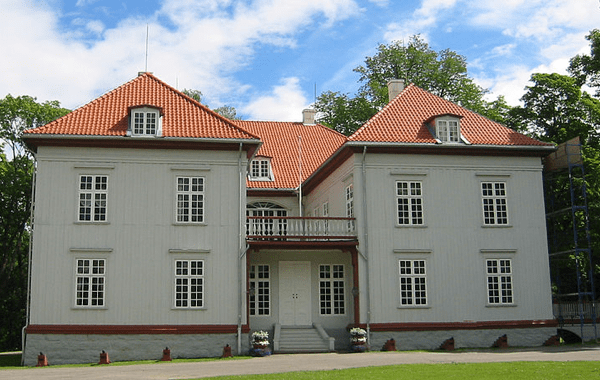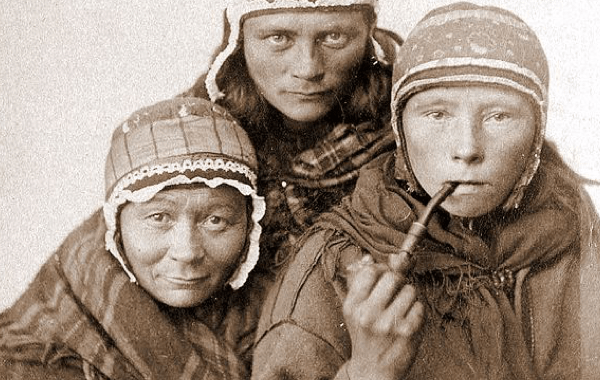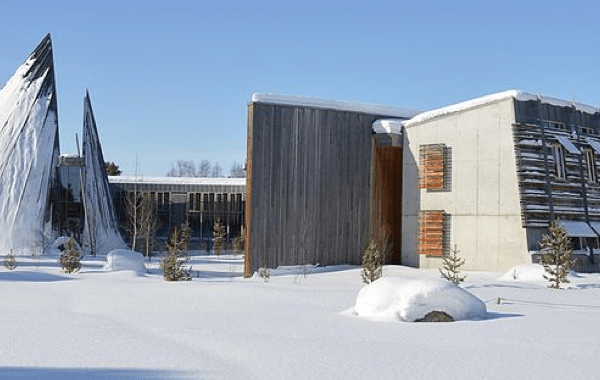The Sámi indigenous minority group has inhabited the Scandinavian Peninsula since approximately 8000 BCE. In Norway, the Sámi lived largely isolated lives until the end of the Middle Ages, as Norwegian settlers and missionaries began to move north. Early missionaries encouraged the use of Sámi language, and for the most part the Sámi were left alone; however, in the mid-19th century there was a rise in Norwegian nationalist sentiment which discouraged the use of languages other than Norwegian. By the start of the 20th century, full rights could only be gained in Norway by speaking Norwegian, leading to a decline in the Sámi language and forced adoption of Norwegian in schools. A gradual shift post-World War II led to protection of Sámi language in schools and media, as well as legal protection of Sámi lands, culture, and an autonomous parliament since 1989. Tensions still exist in some parts of Norway, but Sámi culture and language remain supported by the Norwegian government.
Historical Background
The Sámi are the oldest indigenous people inhabiting the Scandinavian Peninsula, having lived there since approximately 8000 BCE. Their origin is debated, but DNA evidence shows that they are genetically Caucasoid, possibly moving to Scandinavia from the region between the Danube River and Ukraine ten thousand years ago. Sápmi, the Sámi homeland, consists of the areas north of the Arctic Circle in Finland, Norway, Sweden, and Russia; this northern location allowed early Sámi to practice a nomadic lifestyle that centered on reindeer herding, fishing, and hunting. The nomadic nature of their culture and their geographic isolation allowed the Sámi to be untouched by the rest of Europe for centuries beyond paying occasional taxes to Norse chieftains.
During the Middle Ages, the growing power and influence of Germanic kingdoms led the Kingdom of Norway to form the Kalmar Union with Denmark and Sweden, which itself led Norwegian settlers to move into Sámi lands, pushing the Sámi further northwest. Norwegian migration into Sámi lands escalated in the eighteenth century, especially as missionaries sought to convert them from shamanistic beliefs to Christianity. These early settlers rarely attempted to impose the Norwegian language or culture on the Sámi and instead learned to survive in the frozen land from them.
The neutral relations between groups changed in the latter half of the nineteenth century, however, as a wave of nationalism took hold in Norway. Through Norwegenization, the Norwegian government sought to integrate the Sámi into Norway culturally and linguistically. From the mid-eighteenth century, the Sámi language was banned from schools, and from 1898-1959 all classroom instruction had to be in Norwegian. The 1902 Land Sales Act ensured only those who could read and write in Norwegian could own land, forcing many Sámi to give up their land, or adopt Norwegian names and language. Moreover, Sámi documents were invalid in court, place names had to be in Norwegian, and the Sámi language was effectively removed from the public sphere.
In response to a growing concern for minority rights, a 1959 Norwegian commission concluded Sámi language was important to Sámi culture, and in the 1960s Sámi returned to elementary schools, with expansion to secondary education in the 1980s. Sámi media sources developed, and in 1987 the Sámi Act gave Sámi and Norwegian the same legal status. In 1992, the Sámi Parliament was established, although it is an advisory body with no legal or executive power. While the conflict has largely settled, discrimination against the Sámi remains; a member of Parliament was dubbed an “extremist” for speaking in Sámi in 1994, protests broke out in Tromsø in 2011 after the city failed to enact a law for bilingual road signs, and personal acts of discrimination against the Sámi continue to this day. [This section is summarized from Davies & Dubinsky, 2018, pp. 195-205].
A Government of Their Own
The protests at the Alta Dam gave Sámi in Norway an opportunity to unite under a shared ethnic and linguistic background, while also uniting Sámi interests with those of environmentalists and ethnic Norwegians living near them. This newfound mobilization of the Sámi led to the institution of the Norwegian Sámi Parliament, created by the Sámi Act in June 1987. In October 1989, the Sámi Parliament held its first session, giving Norwegian Sámi recognition by their government and legitimizing their language in public and political spheres [Stranden, 2015]. The Sámi Act gave the parliament the right to decide which issues it would consider, while in elections both Sámi and national political parties are given the right to run for elections, tying Sámi and Norwegian governmental organizations together. Even the Progress Party, a Norwegian party that sought to abolish the Sámi Parliament has sent representatives to the body, demonstrating the significance of the Sámi body [Stranden, 2015].
The legitimacy and unity of the Sámi Parliament in Norway contrasts with that of Sámi political bodies in other countries. For example, the only Sámi political parties can participate in the Swedish Sámi Parliament, itself considerably more fractured than its Norwegian equivalent, limiting interactions between the Swedish and Sámi [Stranden, 2015]. Furthermore, and unlike Norway, Sweden has not signed an international 1989 agreement that states indigenous peoples have the right to intercede on matters that impact them. This agreement makes it easier for the Sámi Parliament in Norway to leverage political gains, such as the Finnmark Act of 2005, which returned 95% of land in Finnmark, Norway from the Norwegian government to the Finnmark Estate, a body partially overseen by the Sámi Parliament, after recognizing it was necessary to preserve the land for Sámi culture [Stranden, 2015]. Overall, the creation of the Sámi Parliament has been uniquely effective in Norway in giving the Sámi a voice in governmental policy to preserve their language and culture.
The Alta Dam Controversy
In the 1970s and early 1980s, a political controversy developed over the potential construction of a hydroelectric plant on the Alta River in northern Norway. The artificial lake caused by this plan, promoted by the Norwegian government, would flood the Sámi village of Máse and disrupt the region’s reindeer migration and wild salmon fishing, both of which are traditional Sámi institutions. In 1978, the People’s Action Group was created to oppose and resist the proposed construction. In 1979, seven Sámi activists began a hunger strike outside the Norwegian parliament while activists conducted a sit-in at the construction site in Stilla, blocking the machines and preventing any serious progress on the project [Lawrence, 2011].
The government reacted swiftly and decisively, and considered using military force to help police stop the protestors. The prime minister attempted to prevent the issue from escalating further by having the parliament review the situation. However, the legislative body permitted construction on the dam to continue. When construction renewed in January 1981, over one thousand protestors chained themselves to the site before being forcibly removed by police, marking the first time since World War II that Norwegians had been arrested under anti-rioting laws. In retaliation, Sámi organizations stopped cooperating with the Norwegian government and two Sámi women appealed to the Pope in the Vatican [Lawrence, 2011]. Opposition ceased by 1982, when Norway’s Supreme Court upheld the plans for the plant, although as a smaller-scale project that would displace fewer Sámi and limit environmental impact due to Máse being named a heritage site. Although activists failed to stop the construction of the dam, they were successful in bringing attention to the Sámi as an important ethnic group in northern Norway that belonged on the national agenda [Callahan, n.d.].
Social Media and the Sámi: Exposing Everyday Racism
In the 21st century, Sámi still face issues of discrimination and racism throughout Norway. Over a three-day period in March 2017, Sámi broadcasting stations Sameradion and SVT Sápmi launched a Norwegian-based online campaign asking people from Sámi backgrounds to recount instances of racism and discrimination they had faced [Roden, 2017]. Various hashtags in Southern Sámi, Northern Sámi, and Swedish were promoted across social media, with the slogans translating into English as “#everydayracismtowardssami”. Experiences shared included being called ethnic slurs such as “Lapp,” and the mocking of traditional Sámi clothing and occupations. One participant claimed they avoid identifying as Sámi unless necessary to avoid odd looks or invasive questions. Other comments targeted the Sámi language, including asking why it was necessary to have Sámi taught in homes and schools [Roden, 2017].
While the hashtags were widely supported by Sámi audiences, they were generated among fears of backlash from far-right political factions. As members of a minority group, members of the Sámi broadcasting stations were concerned that large far-right online communities could overtake the original intent of the campaign. This did occur in several Tweets and online posts; in one example the hashtag was included alongside language implying the Sámi were “white trash” and were a culturally inferior group [Roden, 2017]. Tolerance is still publicly encouraged in Norway, but microaggressions and overt attacks by more extreme political factions show the Sámi still face informal discrimination.
Compare Language Similarities
Linguistic Background
1. Genealogy/Relatedness
Referring to the Sámi (Sami, Saami, Samic) language family as a single language is inaccurate; the Sami speak a variety of dialects that were gradually spread throughout Sápmi, the Sami homeland which takes in northern regions of Finland, Norway, Sweden, and Russia. The languages of each of these subgroups are not always mutually intelligible, in part due to this wide geographic spread. Typically, speakers of neighboring dialects can understand each other, but the greater the geographic distance between them, the less likely it is that different speakers can communicate effectively. The number of speakers varies between members of the group; several of the varieties are extinct or nearly extinct, while Northern Sami has an estimated 20,000 speakers. A Finno-Ugric language, Sámi is related to Finnish, Estonian, and Hungarian.
The Sami have inhabited their homeland since 8000 BC, and the Sámi language is theorized to have split into its many dialects during the first millennium AD, with the language descending from eastern Baltic languages moving northwards by 1000-1500 BC. The language was not extensively recorded until the 16th through 19th centuries, when large missionary groups recorded the language in order to better carry out their religious duties. The relative isolation of the Sami limits the amount of historical literature on the language, unlike the better-documented Norwegian.
The Norwegian language is most closely related to Swedish and Danish, and to an extent, the three languages are mutually intelligible. They are North Germanic languages from the Indo-European family, with Urnordisk serving as a common ancestor in use from 200-500 AD before shifting into Old Norse from 500-700 AD. The Viking variant of Old Norse developed from this, lasting from 700-1050 AD and later transforming into Old and then Middle Norwegian by the end of the fourteenth century. A 1387 union with politically dominant Denmark resulted in a Danish-based language used by Norwegian elites, while at the same time a written form of Norwegian ceased to exist. [This section is summarized from Davies & Dubinsky, 2018, pp. 195-205].
2. Phonetics/Phonology
Sami dialects show significant variation in their sound inventories. Here, Northern Sami is given as an example. Northern Sami consists of a large consonant inventory, with most dialects having about 36 consonants. In the labial, dental, and velar categories, Northern Sami distinguishes voiced, voiceless, and aspirated stops, fricatives, and nasals – totaling some 20 consonants. The language also divides alvealor, postalveolar, and palatal place of articulation – with an additional 16 consonants in those categories.
| Northern Sami consonants | |||||||
| Labial | Dental | Alveolar | Postalveolar | Palatal | Velar | ||
| Nasal | voiced | m | n | ɲ | ŋ | ||
| voiceless | m̥ | n̥ | (ŋ̥) | ||||
| Plosive / Affricate | voiceless | p | t | t͡s | t͡ʃ | c | k |
| voiced | b | d | d͡z | d͡ʒ | ɟ | ɡ | |
| postaspirated | pʰ | tʰ | kʰ | ||||
| Fricative | voiceless | f | θ | s | ʃ | h | |
| voiced | v | ð | |||||
| Semivowel | voiced | j | |||||
| voiceless | j̥ | ||||||
| Lateral | voiced | l | ʎ | ||||
| voiceless | l̥ | ||||||
| Trill | voiced | r | |||||
| voiceless | r̥ | ||||||
https://en.wikipedia.org/wiki/Northern_Sami#Phonology
The Northern Sami vowel system has 5 basic vowels (1 low, 2 mid – front and back, and 2 high – front and back). A contrasting long-short vowel distinction yields a total of 10 vowels [Bals et al., 2005]. In addition, Northern Sami has 9 vowel dipthongs, 4 regular and 5 rising.Vowels[edit]
Northern Sami possesses the following vowels:
| Short vowels | Long vowels | Diphthongs | Half-long/ rising | |||||
| Front | Back | Front | Back | Front | Back | Front | Back | |
| Close | i | u | iː | uː | ie̯ | uo̯ | i̯e | u̯o |
| Mid | e | o | eː | oː | ea̯ | oɑ̯ | e̯a | o̯ɑ |
| Open | a | aː | aˑ | |||||
C
Norwegian phonology is quite different from Sami. First of all, it only includes 19 consonants, half as many as Sami. It has in the labial, dental/alveolar, and velar categories, only 5-6 in each – making a voiced/voiceless distinction only with stops. Beyond this, Norwegian only has 2 retroflex consonants and a glottal fricative [h]. The Norwegian vowel system is much more complex. It includes 7 basic vowels, with a short and long contrast making for 14. It also has short and long versions of two rounded front vowels, adding another 4 to the inventory.
These vowels, plus an additional vowel /ə/ “shwa” brings the total to 19 vowels [Kristoffersen, 2000].
- Morphology and Grammar
Sami is a highly inflected, agglutinative language, like Turkish (i.e. one that adds lots of inflectional suffixes after words). Nouns are marked by number and have seven cases across three lexical classes. Verbs occur in five moods in past and present tenses, with conjugations occurring for three persons and three numbers - singular, dual, and plural. Finally, there are three different conjugation classes based by the number of syllables in the base form, and no grammatical distinction based on gender [Davies & Dubinsky, 2018]. Northern Sami word order is subject-verb-object (SVO) in main clauses and SOV in constructions with infinitives or participles. Southern Sami is notable among Sami languages for generally using the SOV order in main clauses [Trosterud, 1994].
In contrast to Sami, Norwegian allows for nouns marked by both number and definiteness, with three types of grammatical distinction based on gender. Verbs can be conjugated in past, present, and future tenses, as well as by mood and voice, in both infinite and noninfinite forms [Davies & Dubinsky, 2018]. Norwegian syntax is primarily SVO. However, like many other Germanic languages, it follows the V2 rule, which means that the finite verb is always the second element in a sentence regardless of which element is placed first [Holmes & Enger, 2018].
- Lexicon and Vocabulary
The Sami languages, due to extensive and continual linguistics contact, contain many Scandinavian and some Russian loanwords [Britannica, 2018]. Keep in mind that Sami and Finnish, being members of the same language family (along with Estonian), would not be thought of a borrowing from each other.
Norwegian vocabulary is primarily of Old Norse origin. Middle Low German is the main source of loanwords, having a significant influence on Norwegian vocabulary from the late Middle Ages onwards. Many of these loanwords, however, while found in Bokmål and many dialects, are absent from Nynorsk, which retains or has substituted words derived from Old Norse. Nynorsk thus shares more vocabulary with Icelandic and Faroese than does Bokmål. Norwegian also borrowed words from Danish and Swedish and continues to do so. Today the main source of new borrowing is English [Wikipedia: Norwegian language, 2021].
- Orthography/Writing System
Sami orthographies vary with respect to different Sami languages and dialects. For example, the orthography used to write Northern Sámi has experienced multiple changes. Traditionally, Norway, Sweden, and Finland — the three countries where Northern Sámi is spoken — used separate orthographies for teaching the Sami. This changed in 1979 when a Saami Council-led effort to standardize a pan-Scandinavian orthography for Northern Sámi [Hovdhaugen et al., 2000].
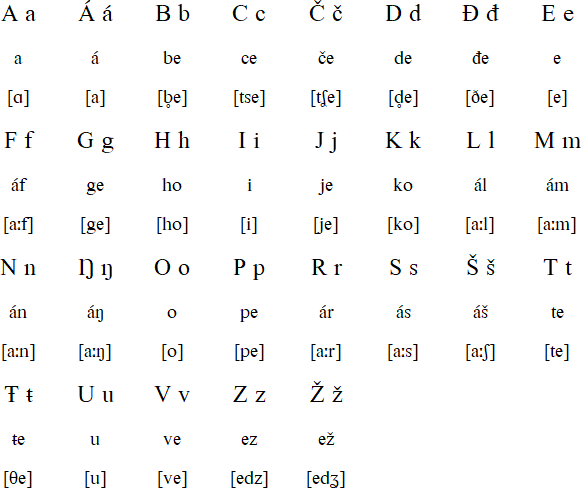
Image: Northern Sami alphabet. Retrieved from https://omniglot.com/writing/northernsami.htm
Further attempts were made to create a writing system applicable to all Sami languages with a single spelling system, and in order to account for the variation between different Sámi languages, such as the Unified Sami Orthography. The primary purpose of this orthography was to make communication easier between people who speak different Sami languages. However, the differences between certain Sami languages appear to be too great for such unified system to work successfully [Omniglot: Unified Sami Orthography, 2021].
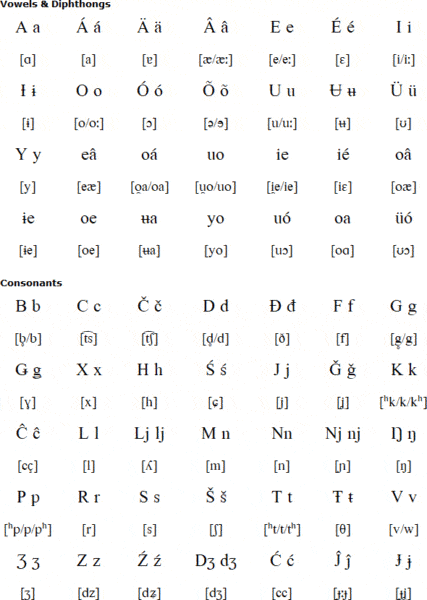
Image: Unified Sami Orthography. Retrieved from https://omniglot.com/conscripts/uso.htm
The Norwegian alphabet is based upon the Latin alphabet and is identical to the Danish alphabet. Since 1917 it has consisted of the following 29 letters, including Norwegian specific letters Æ, Ø, and Å. The letters C, Q, W, X and Z are not used in the spelling of indigenous words [Omniglot: Norwegian, 2021].
- Discourse/Sociolinguistic Factors/Influences on Development/History
Norway’s 1814 independence realized the need for a common written Norwegian language. Two forms emerged, Landsmål (‘Country Language’) and Riksmål (‘National Language’); the former was a new written language adapted from Old Norwegian, while the latter was based on Danish spelling and grammar. These were then developed further into Nynorsk (‘New Norwegian’) and Bokmål (‘Book Language’) in 1929, with Nynorsk preferred in the more rural regions of western Norway and the mountainous regions, and Bokmål favored by the urban majority outside these areas. Both forms exist in Norway today, and are largely interchangeable, if distinct forms of Norwegian. Rising nationalism leading up to World War II led to public support of Norwegianization, pushing the Sámi to forgo their language in favor of Norwegian in schools and in society, and leading to a linguistic conflict that would last for over a century [Britannica, 2011].
Resources
References
Callahan, S. (n.d.). The Alta Dam Controversy. Retrieved December 7, 2018, from
http://www.environmentandsociety.org/tools/keywords/alta-dam-controversy.
CIA. (2021, July 1). World Factbook: Norway. Retrieved July 13, 2021, from https://www.cia.gov/the-world-factbook/countries/norway/.
Davies, W., & Dubinsky, S. (2018). Language Conflict and Language Rights: Ethnolinguistic Perspectives on Human Conflict. Cambridge UP.
The Editors of Encyclopaedia Britannica. (2020). Sami. Retrieved July 13, 2021, from https://www.britannica.com/topic/Sami.
Hval, H. (1998, February 24). The History of Norwegian. Retrieved November 3, 2018, from
http://linguistics.byu.edu/classes/Ling450ch/reports/norwegian.html
Lawrence, W. (2011, January 30). Saami and Norwegians protest construction of Alta Dam,
Norway, 1979-1981. Retrieved December 7, 2018, from
https://nvdatabase.swarthmore.edu/content/saami-and-norwegians-protest-construction-alta-dam-norway-1979-1981.
Minority Rights, (n.d.). The Sami. Retrieved November 10, 2018, from
https://minorityrights.org/minorities/sami-2/
Roden, L. (2017, March 28). Campaign launched to highlight 'everyday racism' against Sami
people. Retrieved Nov. 8, 2019 from https://www.thelocal.se/20170328/campaign-
launched-to-highlight-everyday-racism-against-sami-people.
Stranden, A. (translated by Bazilchuk, N).. (2015, February 9). The Sámi in Norway have more influence on politics than the Swedish Sámi. Retrieved from http://sciencenordic.com/sámi-norway-have-
more-influence-politics-swedish-sámi
Linguistic Background References:
References
Bals, B. A., Odden, D., & Rice, C. (2005). Topics in North Saami Phonology. Retrieved 26 July 2021. http://www.ling.ohio-state.edu/~odden/Saami.pdf.
Britannica, T. Editors of Encyclopaedia (2011, October 18). Norwegian language. Encyclopedia Britannica. https://www.britannica.com/topic/Norwegian-language.
Britannica, T. Editors of Encyclopaedia (2018, January 12). Sami language. Encyclopedia Britannica. https://www.britannica.com/topic/Sami-language.
Davies, W., & Dubinsky, S. (2018). Language Conflict and Language Rights: Ethnolinguistic Perspectives on Human Conflict. Cambridge UP.
Holmes, P. & Enger, H.-O. (2018). Norwegian: A Comprehensive Grammar. Routledge, Abingdon.
Hovdhaugen, E., Karlsson, F., Henriksen, C., & Sigurd, B. (2000). The History of Linguistics in the Nordic Countries. Helsinki, Finland: Societas Scientiarum Fennica.
Kristoffersen, G. (2000). The Phonology of Norwegian. Oxford University Press.
Omniglot, Norwegian. Retrieved 26 July 2021 from https://omniglot.com/writing/norwegian.htm.
Omniglot, Unified Sami Orthography. Retrieved 26 July 2021from https://omniglot.com/conscripts/uso.htm.
Trosterud (1994). Auxiliaries, Negative Verbs and Word order in the Sami and Finnic Languages. Ago Künnap (ed.): Minor Uralic Languages: Structure and Development. Tartu. pp.173-181.
Wikipedia. Norwegian Language. Retrieved 26 July 2021 from https://en.wikipedia.org/wiki/Norwegian_language.
Image Credits
Altaelva River- Canyon, Finnmark, Norway [Photograph found in Wikimedia Commons]. (2007, August 25). Retrieved from https://commons.wikimedia.org/wiki/File:Altaelva_canyon.JPG
- K.KongenTaler [Photograph found in Wikimedia Commons]. (2000, November 2). Retrieved from https://commons.wikimedia.org/wiki/File:H.M._Kongen_taler_(10345062316).jpg
Sami Flag Large [Photograph found in Wikimedia Commons]. (2005, February 5). Retrieved from https://commons.wikimedia.org/wiki/File:Sami_flag_large.png.
Nordkappsami [Photograph found in Wikimedia Commons]. (2006, June 28). Retrieved from https://commons.wikimedia.org/w/index.php?curid=15857923
Credits
Posted: Sept 2021
Previous versions: Oct 2018
Contributing Analysts: Grace Alger and Jill Boggs
Editors: Gareth Rees-White, Elena Galkina
